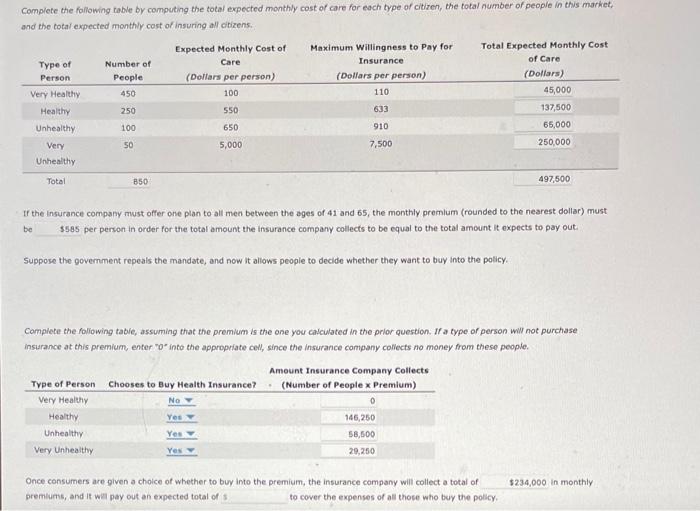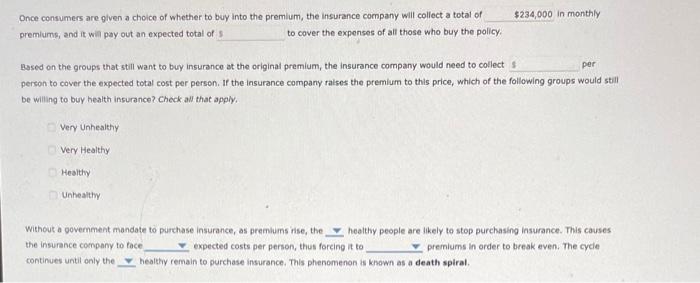please help asap

options for last section 1. : most/higher 2. higher/lower 3. increase/decrease 4. least/most
ages of 41 and 65 fall into one of four health categories: very healthy, healthy, unhealithy, and wer Arrordable Care Act (PPACA), the povemment mandates that insurance companies must charge the er, age, and geographic reglon. The insurance company must determine the premium it should charge In order to complete your analysis, make the following assumptions: 1. The insurance company does not incur any costs to run or administer the policies, and it does not make any profit. 2. The population is large enough so that expected values hold at the aggregate level, 3. Anyone who pays the monthly premium receives complete coverage of all medical expenses (in other words, everyone is offered full insurance). 4. All citizens are risk averse and therefore are wiling to pay a premilum above the expected value of their costs, up to the amount Indicated in the column "Maximum Wilinghess to Pay for Insurance" in the following table. The following table presents the number of very healthy, healthy, unhealthy, and very unhealthy people; as well as the expected monthly cost of providing care for each category. The table also presents the maximum that an indlyidual is willing to pay within each group, which is higher than the expected cost. This reflects the fact that people are generally risk averse. In the context of health insurance, this means that people prefer to pay some amount for certain each month than to face paying the full costs of somewhat unpredictable care. Complete the following table by computing the total expected monthly cost of care for eoch type of citiren, the total number of people in this market, and the total expected monthly cost of insuring all citizens. If the Insurance company must offer one plan to all men between the ages of 41 and 65 , the monthly premlum (rounded to the nearest dollar) must be per person in order for the total amount the insurance company collects to be equal to the total amount it expects to pay out. Suppose the govemment repeals the mandate, and now it allows people to decide whether they want to buy into the policy. Complete the following tabie, assuming that the premium is the one you calculated in the prior question. If a type of person will not purchase insurance at this premium, enter " 0 inte the appropriate cell, since the insurance campany coliects no money from these people. Once consumers are piven a choice of whether to buy into the premium, the insurance company will collect a total of in monthly premlums, and it wia pay out an expected total of to cover the expenses of all those who buy the policy. Once consumers are given a choice of whether to buy into the premium, the insurance company will collect a total of in monthly premiums, and it will pay out an expected total of to cover the expenses of all those who buy the policy. Based on the groups that still want to buy insurance at the original premium, the insurance company would need to collect person to cover the expected total cost per person. If the insurance company ralses the premium to this price, which of the following groups would still be willing to buy health insurance? Check all that apply, Very Unhealthy Very Healthy Healthy Unhealthy Without a govemment mandate to purchase insurance, as premiums ise, the healthy people are likely to stop purchasing insurance. This causes the insurance company to face expected costs per person, thus foreing it to premiums in order to break even. The cycle continues until only the healthy remain to purchase insurance. This phenomenon is known as a death spiral










